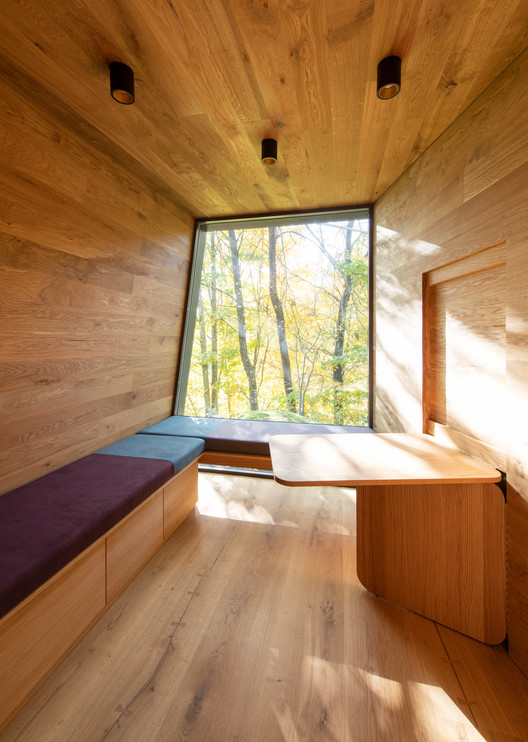House HC Wim Heylen
2017-11-18 05:00
© Wim Heylen
C.Wim Heylen


架构师提供的文本描述。这座梯田房屋位于比利时旺代尔盖姆58年的一个住宅项目中。该项目具有典型的组合,相同的排屋与交替反映的地面计划。他们都有一个单层延伸和半私人道路在后面的地块连接各种车库和花园储藏室。多年来,许多居民将扩建区之间的休憩空间填上了廊道和二级建筑,从而失去了与外部空间的联系。
Text description provided by the architects. The terraced house is located in a housing project from '58 in Wondelgem, Belgium. The project has the typical combination of identical row houses with alternately mirrored ground plans. All of them have a single-storey extension and a semi-private road at the back of the plot connecting the various garages and garden storages. Over the years many residents have filled up the open space between the extensions with verandas and secondary buildings, and by thus have lost relationship with the exterior space.
Unfolded Facade
展开正面


由于这个原因,这个屋苑的阳台、二次扩建和花园储藏室都被毁了。作为新卷的起点,这座建筑恢复了原来的状态。它与整个地块的主要结构相连,但随后向原延伸线工作,然后再向花园打开。由于内部和外部空间的压缩和减压,房子展开进入花园,并带来绿色和日光进入室内,没有使用轻穹顶或露台。由于这种结构,室内空间可以按需要定位:就餐区转向西面,捕捉黄昏的阳光。露台是这种运动的延续:它从室内地板流入一条通往土路的小径。
For this reason, the veranda, a secondary extension and the garden storage of this rowhouse were broken down. The building was returned to its original state as the starting point of the new volume. It connects with the main structure across the entire width of the plot, but then works towards the line of the original extension and opens again towards the garden. Due to this compression and decompression of interior and exterior space, the house unfolds into the garden and brings green and daylight into the interior, without the use of light domes or patios. Because of this configuration, the interior space could be orientated as desired: the dining area turns towards the west to capture the evening sun. The terrace is a continuation of this movement: it flows from the interior floor into a path to the dirt road.
© Wim Heylen
C.Wim Heylen


整个体验与预期的一排房子的外观和感觉不同,它是由展开的外墙提供的宽边角:它不是一栋有隧道景观的排屋,而是一间彼此之间和外部有着开放关系的不同空间的房子。
The total experience differs from the expected look and feel of a row house through the wide parama offered by the unfolded façade: it is not a row house with tunnel view, but .one with different spaces in an open relationship with each other and the exterior




建筑师故意选择保留现有住宅的氛围。厨房、餐厅和浴室是装修的重点,剩下的空间几乎可以保持不变。在底层,新的延伸与现有的房子是共生的;没有与过去断绝关系,而是提到了将过去和现在结合在一起的具体材料和要素。拆除后的砖块被回收利用,并将混凝土结构冠以作为主建筑后立面的延续。露台和厨房的石板散发着58年的精神。
The architect deliberately chose to preserve the atmosphere of the existing home. Kitchen, dining room and bathroom were the focus point of the renovation, the remaining spaces could maintain virtually unchanged. On the ground floor, the new extension is in symbiosis with the existing house; rather than making a break with the past, a reference was made to specific materials and elements to bring the past and present together. The bricks of the demolition were recycled and crown the concrete structure as a continuation of the back facade of the main building. The flagstones of the terrace and the kitchen breathe the spirit of '58.
© Wim Heylen
C.Wim Heylen


从同样的意义上讲,上层建筑的平面图仍然保留了很大一部分,但浴室被搬到了一个新的、更广阔的地方。这一空间是进一步增加视觉上的平行放置的镜子,创造了无限的反光重放。在其中一个镜子后面,浴室周围的墙壁弯曲,形成一个淋浴空间。
In the same sense, the plan of the upper floor remained largely preserved, but the bathroom was moved to a new, broader location. This space is further increased visually by a parallel placement of mirrors that create an infinite replay of reflections. Behind one of these mirrors a wall curves around the bath creating a shower space.




































Architects Wim Heylen
Location Ghent, Belgium
Architect in Charge Wim Heylen
Area 160.0 m2
Project Year 2017
Photographs Wim Heylen
Category Houses
Manufacturers Loading...
























